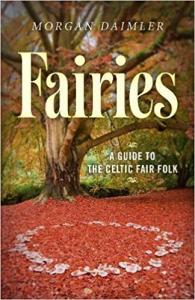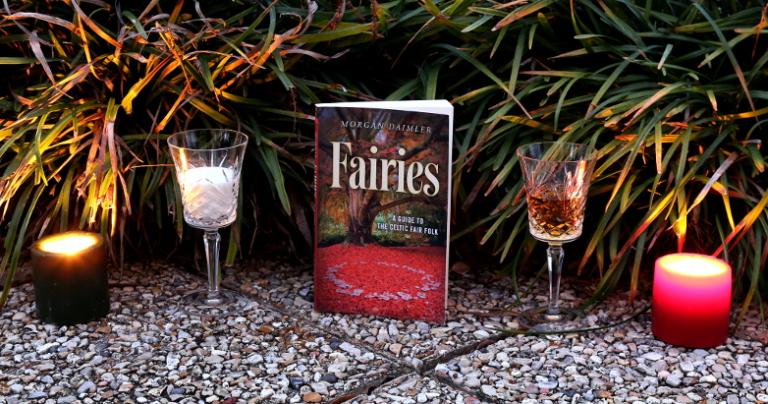I never had any intention of dealing with fairies.
I wanted to worship the Gods, honor my ancestors, and form reciprocal relationships with other beings. I thought fairies were just a romanticized version of Nature spirits. Surely it would be better to work with the spirits of the elements and the local land spirits than to deal with Brownies, Goblins, and Red Caps. Right?
If the road to Hell is paved with good intentions, the road to Fairy is paved with naïve assumptions.
The Re-emergence of the Fair Folk in the Ordinary World was my most widely read post in 2017. I wrote it in part because I was getting a lot of questions about fairies, but mainly because my experiences of the Otherworld and its various denizens were increasing. I continued this theme later in the year with Bargaining at the Goblin Market.
We live in a very different world from our Victorian ancestors who wrote narrative poetry about the dangers of the Goblin Market … It’s one thing to warn people to avoid the Goblin Market if they see it deep in the forest. It’s a very different thing when the Goblin Market sets up shop across the street from your house.
I’ve only written about a fraction of my experiences with the Fair Folk. If you’re wondering why, that brings us to Fairies, the new book by Morgan Daimler.
A Guide To The Celtic Fair Folk
Subtitled A Guide To The Celtic Fair Folk, this book is both complete and accessible. It doesn’t tell you everything there is to know about fairies (that would require multiple volumes, not just 246 pages), but it tells you enough for you to understand what you’re getting into when you encounter them.
I know of no one else who has Morgan Daimler’s extensive knowledge of fairy lore and her first-hand experience of the Good Neighbors. Most of Fairies is written from the first perspective – that of a folklorist. The book draws extensively from scholarly sources, which are attributed. If you want to go read them for yourself – and I suggest you do, at least a few of them – they’re all there in the bibliography.
The true value of this book isn’t its information, it’s the first-hand perspective that it brings. It’s one thing to read someone’s anthropological account of old tales. It’s something entirely different to read the accounts of someone who’s been there and done that.

There is a bit of overlap with Daimler’s previous book Fairycraft – Following the Path of Fairy Witchcraft, but only a bit. That book reinterprets the Celtic Fairy Faith in a modern Pagan context. This book explains what the Celtic Fairy Faith actually is. If you haven’t already read Fairycraft, read Fairies first.
Fairies begins with an explanation that many of our attitudes – and much of our misinformation – about the Fair Folk come from the Victorian era.
This … can rightly be viewed as a reflection of the wider culture of the time, which was one of the middle class, of repression and sanitization, one that in many ways sought to rewrite unpleasant stories into pleasant ones to create an illusion of a better world.
Getting to the truth of the matter requires undoing the Victorian whitewashing.
The idea here is to remove the filters layered over modern understanding because of these views and provide instead the perspective of the cultures that the beliefs come from.
Chapter 1 covers what we know of the land of Fairy, and the many conflicting accounts of it.
None of them are wrong, and none of them are exactly right either, and that’s your first lesson about Fairy: it is in all ways and always a contradiction.
Chapter 2 presents “Basic Facts About Fairies” and makes it clear that different people have seen them in different ways at different times. During the medieval witch trials, several of the accused said they were dealing with fairies – their accusers claimed they were dealing with demons or even with the devil himself. This wasn’t simply twisting their words to get a conviction. Common folk had always encountered fairies and took them for what they are. Those with more education – and more theological indoctrination – placed them in a Christian worldview, which insisted that if they weren’t part of official church teaching, they had to be working for the devil.
The third chapter discusses “The Courts and Divisions in Fairy” and points out that:
The idea of the courts as such is unique to Lowland Scots lore and more generally Scottish folklore. It is not found in Welsh or Irish fairylore … Whether the courts have always existed or not they have certainly been a part of fairylore belief for centuries now and are ingrained in modern lore.
Further chapters cover “The Kings and Queens” “Denizens of Fairy” and “Fairies in Tradition. I’ve had my own experience of one of the Fairy Queens. It seemed a bit presumptuous – what would a Fairy Queen want with an ordinary Druid (especially a Druid, but that’s another story for another time)? But the folklore makes it clear that this isn’t an unusual experience. Many people have encountered one or more of the Queens.
Why would they want to interact with us anyway? That is ultimately a matter of speculation, but Daimler says:
There is a dependence between the two peoples that is complex and goes back a long way indeed. This almost symbiotic relationship is more than just a matter of our worlds’ intersection, or our need to appease them to ensure good crops. For good or ill they can affect us in profound ways and we can, perhaps, affect them as well.
I’m convinced that interaction and interdependence is only getting stronger.
Fairies in the Modern World
Daimler quotes 20th century British folklorist Katharine Briggs, who said: “Yet, however often they may be reported as gone, the fairies still linger.” This is pretty much what contemporary religious scholar Jason Josephson-Storm said in The Myth of Disenchantment. It isn’t that the world has become disenchanted. Rather, we have forgotten how to recognize enchantment for ourselves. Daimler says:
We have not lost our connection to Fairy; we have lost our sense of enchantment, which is the lens through which we have always viewed the unseen world … to reclaim it we have to be willing to experience life, to embrace the moments of enchantment when we find them – and once we know them perhaps we can learn how to make them for ourselves.
And that brings us to the value of this book.
We have mystical and religious experiences all the time. Most times we don’t recognize them. But even when we do, we interpret them in the context of what we know about the world and what we believe is and isn’t possible. For most of us, that means pop culture filtered through a materialistic worldview. And that’s how we get the Disneyfied view of fairies that at best is inaccurate and disrespectful and at worst is downright dangerous.
The first step to dealing with fairies is to read as much folklore about them as possible. Not the watered-down fairytales, but the real folklore, the gathered stories collected from people who actually believed and still believe in these beings.
Fairies will get you started on understanding the folklore. It provides a good description of the Fair Folk, who they are, where and how they live, and how we can best interact with them. And it constantly reminds us of the hazard of trying to fit everything into a simple black or white narrative.
The more you seek to study Fairy the more you begin to understand that every answer is a contradiction and every truth has its equally true opposite.
I’m convinced the Fair Folk are becoming more and more active in the ordinary world. Those of us with a Pagan, polytheist, or magical approach to life are far more likely to encounter them, and we need to know how to do that politely and skillfully. I strongly encourage you to move Fairies to the top of your reading list.
 Fairies: A Guide to the Celtic Fair Folk
Fairies: A Guide to the Celtic Fair Folk
by Morgan Daimler
published by Moon Books, December 2017
246 pages
trade paperback: $21.95, e-book: $7.99
For those who care about such things, I bought my copy of Fairies. Morgan Daimler is a friend and I hope this book sells well – for the benefit of those who read it as well as for the benefit of the author – but my first obligation in a review is to the reader. If it wasn’t worth your time and money, I’d conveniently forget to review it.

















